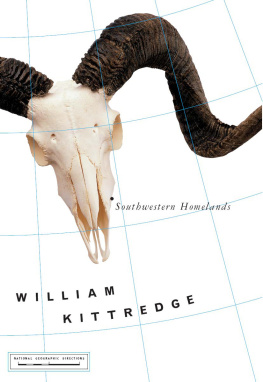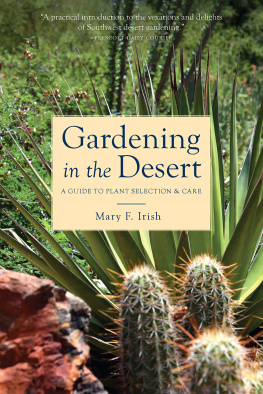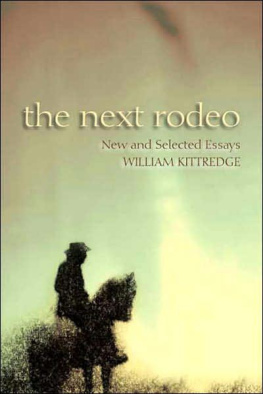WILLIAM KITTREDGE
Southwestern Homelands
NATIONAL GEOGRAPHIC DIRECTIONS
NATIONAL GEOGRAPHIC
Washington D.C.
Published by the National Geographic Society
1145 17th Street, N.W., Washington, D.C. 20036-4688
Text copyright 2002 William Kittredge
Map copyright 2002 National Geographic Society
All rights reserved. No part of this book may be reproduced or transmitted in any form or by any means, electronic or mechanical, including photocopying, without permission in writing from the National Geographic Society.
Library of Congress Cataloging-in-Publication Data
Kittredge, William.
Southwestern Homelands / William Kittredge
p. cm.(National Geographic directions)
ISBN: 978-1-4262-0910-9
1. Southwest, NewDescription and travel. 2. Kittredge, WilliamJourneysSouthwest, NewHistory. I. Title II. Series.
F787.K54 2002
979dc21
2002019349

One of the worlds largest nonprofit scientific and educational organizations, the National Geographic Society was founded in 1888 for the increase and diffusion of geographic knowledge. Fulfilling this mission, the Society educates and inspires millions every day through its magazines, books, television programs, videos, maps and atlases, research grants, the National Geographic Bee, teacher workshops, and innovative classroom materials. The Society is supported through membership dues, charitable gifts, and income from the sale of its educational products. This support is vital to National Geographics mission to increase global understanding and promote conservation of our planet through exploration, research, and education. For more information, please call 1-800-NGS LINE (647-5463), write to the Society at the above address, or visit the Societys Web site at www.nationalgeographic.com.
For the true traveling companion, Annick Smith
CONTENTS
Southwestern Homelands

Preface
Every continent has its own spirit of place.
Every people is polarized in some particular locality, which is home, the homeland.
D. H. L AWRENCE
Studies in Classic American Literature
At the trailhead, waiting for the man with the horses, we were stunned by light, the yellow-white needles of the cholla backlit by sunrise, abruptly luminous. So this was the Sonoran Desert.
Annick and I were going for a day in the Superstition Mountains, a range which rises abruptly in a line of dark basalt cliffs at the eastern edge of the Phoenix metroplex. We were there with the attorney general of Arizona, a man obsessed with rediscovering the Lost Dutchman Mine, a legendary vein of gold-bearing quartz. Examples of that quartz existed. They were fabulous, thick with clots of gold. But all idea of the mines location died with the man who found it. Searching in the Superstitions was the attorney generals hobby. Because of my childhood, I was sympathetic.
My grandfather on my mothers side came of age in a mining camp. Having run off from his fathers farm in Wisconsin, by the age of fourteen he was sharpening steelpicks and pry-barsworking as a blacksmith in Butte, Montana. He wandered to Old Mexico, and up to Goldfield and Rhyolite in Nevada before settling and marrying in Grants Pass, Oregon, where he and a brother opened a blacksmith and horseshoeing shop. But that failed and most of his working life was spent blacksmithing for COPCO, the California-Oregon Power Company. His name was Al Miessner, and he was the most openhanded man Ive known.
When I was a boy Id follow Al up the alley behind the house on Jefferson Street in Klamath Falls where he lived with my grandmother, to the door of a remodeled garage where a mining-camp pal of his, a man crippled deep underground, lived a sort of hermits life. Theyd sip bottles of home brew and talk about the runaway boys theyd been. Too young to know a damned thing. Or care. The old crippled man would struggle to stand, raise his bottle, and curse the mines, and Al would smile. They had known heroic times. What to say? My heart breaks for them, so long dead, and for me, without them.
So, having grown up on stories like those, and because of the example of my parents, who were bravehearted in their own ways, I yearned to take part in legendary doings. But no such luck in the Superstitions. No gold. We had a semi-gourmet camp lunch, in the shade of great-armed saguaro cactus instead.
Not long after, I was in a room with mountaineers who were asked to tell us what they thought they were doing as they roped up to risk their being on perpendicular stone walls in the vastnesses of the Alps and the Rockies and the Andes and Asian ranges. They surprised their audience by talking about intimacy, about being at home on the rock faces, and staying happy on the endorphins generated by their bodies. As I understand it, they were talking about drifting and dreaming, nomadic leaning and learning, and how all can be a continual move toward home.
Going south is a pervasive notion in the northern Rockies, where I live. It has to do with fleeing winter. Often we go to the American Southwest, arid lands bounded by the watersheds of the Colorado and Rio Grande Rivers.
Seeking warmth and sunlight in a land where spicy food, music, and frivolity are understood to be ordinary human needs, our mood lifts as we go. Flight involves a spot of reinventing the sweet old psychic self.
Our species evolved on the run. Part of us yearns constantly toward nomadism; were emotionally hardwired to every once in a while hit the road. As my old pal, the poet Richard Hugo, said, The car that brought you here still runs.
Its an ancient dream: Walk out, and as you go listen while the world in its intricacy sings and hums. The child on its mothers hip listens as she moves on through the world, and speaks the names. In the Southwest her litany might go badger, quail in flight from the bosque, cotton fields, ocotillo, coyote skull, mudhead kachina, roadrunner, expressway.
Entering my seventh decade, I usually opt for quiet pleasures and diversions. No more nonstop drinking and driving. I like to contemplate the stars and planets surrounding a cup of moon in the night sky over Arizona. Or ease along the banks of Cave Creek, below the reddish cliffs on the eastern edge of the Chiricahua Mountains, in the quick presence of hummingbirds. I want to unreservedly love my beloved, and fool aimlessly around while its still possible.
At the same time, without purposes we wither. So its useful to understand that travel is not altogether an indulgence. Going out, seeking psychic and physical adventures, can reawaken love of the shifting presence of the sacred Zen ten thousand things we find embodied in the wriggling world. Travel, then, is a technique for staying in touch, a wake-up call, not a diversion but a responsibility.
Journeying is ideally a move toward reeducation, but its also a try at escape from our insistent homebound selves, from boredom or from too much to do, not enough quietude, from the mortal coil of who weve lately been.










